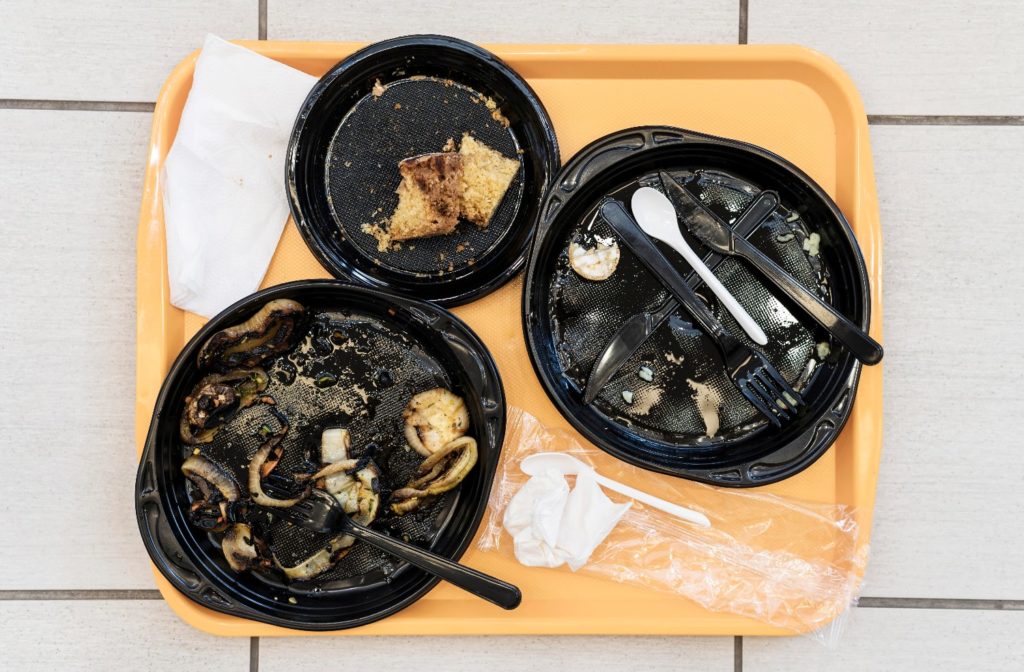
Michaela Dvorakova
(MFood Tech, R&D Specialist)
The food industry has also benefited from this industrial development, however, today we see that plastics pose a significant risk to our health and environment.
Plastic
Plastics are large organic molecules made of carbon-containing monomers bonded into polymers. They have diverse physical and chemical characteristics, making them highly versatile.
Several properties are considered when designing plastic packaging:
- Density
- Degree of polymerization
- Thermal properties (glass transition temperature, melting temperature, crystallization temperature, enthalpy, heat expansion, and heat deformation temperature or HDT)
- Chemical resistance
- Permeability (solubility and diffusivity)
- Physical properties (coefficient of friction, tensile strength, elongation, viscosity, elasticity, plasticity)
- Morphological properties
Types of plastics
- Thermoplastics (can be remelted and recycled without altering mechanical properties).
- Thermosets (cannot be reshaped once formed – this includes Epoxy Resins, Phenolics (Bakelite) or Polyurethane).
- Elastomers (can deform and return to their original shape, for example rubber – natural, synthetic, silicone).
The most common plastics are
- Polyethylene (PE)
- Polypropylene (PP)
- Polyethylene Terephthalate (PET)
- Polystyrene (PS)
- Polyvinyl Chloride (PVC)
- Polylactic Acid (PLA)
All these are classified under thermoplastics, meaning they can be melted and reformed without significant changes in mechanical properties.[1,2]
Advantages of using plastic as food packaging material
Plastics offer numerous advantages that make them a popular choice for food packaging. One of the primary benefits is their lightweight nature, which reduces transportation costs while maintaining significant strength compared to other materials.
They are also cost-effective to produce, ensuring affordability for manufacturers and consumers alike. Their chemical inertness and excellent resistance to oils, chemicals, and corrosion protect food from contamination, while their transparency allows consumers to view the product inside.
Plastics exhibit excellent gas and water vapor barrier properties, preserving food freshness and extending shelf life. Their sealing capabilities prevent leaks and protect contents from environmental exposure.
Plastics can be reused and recycled, reducing waste, and their energy-efficient production minimizes air pollution while helping prevent food spoilage.
Disadvantages of using plastic as food packaging material
Despite their many benefits, plastics as food packaging present several drawbacks. One of the main concerns is their environmental impact, as not all plastics are recyclable, and even recycled materials often cannot be reused for the same purpose.
Non-recyclable plastics contribute significantly to pollution, and improper disposal can damage ecosystems and harm wildlife.
Additionally, while plastics are durable, they are prone to scratching and have limited resistance to high heat and certain solvents, which can compromise their functionality in specific applications.
Non-recyclable plastics contribute significantly to pollution
Another significant issue is the potential health risks associated with some types of plastics. Certain plastics, such as those containing PVC and phthalates, may leach harmful chemicals into food, particularly when exposed to high temperatures. This chemical migration can pose risks to human health and food safety.
Plastics’ low cost and versatility are offset by
- poor gas and vapor protection
- environmental impact
- reliance on non-renewable resources
- long decomposition times
Chemical reactions and potential health hazards
Chemical migration from plastic food packaging involves release of hazardous substances, including
- intentionally added chemicals (e.g., monomers, additives)
- non-intentionally added substances (NIAS) like impurities and degradation products
Common migrants include phthalates, bisphenols (e.g., BPA), PFAS, melamine, and heavy metals (cadmium, lead, mercury), posing significant health risks.
Endocrine disruption is a major concern, with chemicals like BPA, phthalates, and PFAS linked to
- infertility
- obesity
- cancer
- developmental delays in children
Studies show BPA migration increases under heat or prolonged exposure, particularly in low-quality containers, emphasizing the need for stricter regulations on bisphenols in food contact materials.
PFAS have been found to migrate from various packaging types, with evidence showing high persistence and links to
- immune dysfunction
- carcinogenicity
- impaired child development
Their frequent presence in food packaging has prompted calls for bans on PFAS in food contact materials globally.[8,9]
Phthalates
Phthalates are commonly used as plasticizers, especially in PVC-based packaging to enhance flexibility. These substances have been linked to endocrine disruption, leading to
- immune and metabolic diseases
- reproductive abnormalities
Studies have shown that exposure during pregnancy can result in preterm births, low birth weights, and altered hormonal levels in newborns.
During childhood, phthalates are associated with asthma, obesity, and other developmental disorders.
Pregnancy and birth outcomes
A study involving 5,006 mother-child pairs across 13 U.S. sites found that prenatal exposure to di(2-ethylhexyl) phthalate (DEHP) and similar substitutes was associated with adverse birth outcomes, including preterm birth and low birth weight.
They found that the 10 percent with the highest levels of DEHP metabolites had a 50 percent higher chance of giving birth before the 37th week of pregnancy compared to the 10 percent with the lowest levels.[10]
Childhood health issues
The study followed 100 participants from a Swedish birth cohort, analyzing urine samples at age 4 for 10 phthalate metabolites. Weight and height were measured at ages 4, 8, 16, and 24.
The results showed associations between higher urinary concentrations of diisononyl phthalate (DINP) metabolites and an increased risk of overweight/obesity up to age 24, as well as a higher body fat percentage at age 24.[11]
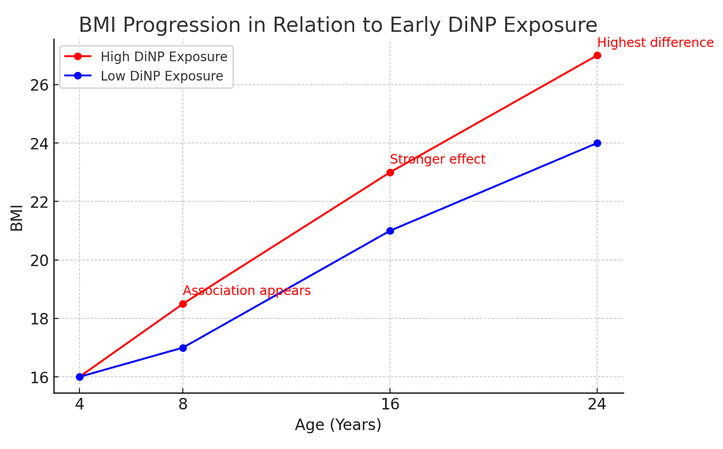
Bisphenols (BPA and Derivatives)
BPA is a key monomer in polycarbonate plastics and epoxy resins used in food cans, water bottles, and baby bottles. Its derivatives, such as BPS and BPF, are used as substitutes in BPA-free products.
Despite their intended safety, these derivatives exhibit similar endocrine-disrupting properties. BPA and its analogs disrupt estrogen levels, affect thyroid hormone regulation, and can interfere with fetal development, potentially causing neurodevelopmental and metabolic disorders.
BPA has also been classified as an endocrine-disrupting chemical (EDC) under the REACH regulation, highlighting its significant hazards.
Chinese study from 2020 analyzed data from 29 literatures involving 88,891 participants and found that exposure to certain endocrine-disrupting chemicals (EEDs), including BPA, phthalates, and organochlorine pesticides, was positively associated with an increased risk of cardiovascular disease (CVD).
The study also found that BPA exposure was linked to factors such as waist circumference, high-density lipoprotein (HDL), body mass index (BMI), and age.[12]
Per- and Polyfluoroalkyl Substances (PFAS)
PFAS are widely used in grease-resistant food packaging, such as fast food wrappers, pizza boxes, and microwave popcorn bags.
These chemicals are extremely persistent in the environment and bioaccumulate in the human body. Health risks associated with PFAS include
- liver dysfunction
- testicular and liver cancers
- immune system suppression
- high cholesterol levels
- ulcerative colitis
Their resistance to degradation poses additional environmental challenges, contributing to long-term pollution.
The article review from 2021 shows the toxicity and human health effects of per- and polyfluoroalkyl substances (PFAS).
The U.S. EPA lists over 8,000 PFAS, with more than 600 currently in commercial use. Epidemiological studies link PFAS exposure to immune suppression (e.g., a 39% reduction in diphtheria antibody levels in children), liver disease, kidney disease, reproductive disorders, and cancer.
The C8 Science Panel found
- 1.35 times increased risk of testicular cancer
- 1.10 times hazard ratio for kidney cancer
The C8 Science Panel was a group of independent scientists tasked with investigating the health effects of exposure to the toxic chemical PFOA (C8) on residents living near a DuPont facility.
PFAS exposure shows to suppress the immune function
Studies also show PFAS impact thyroid hormones, with women exposed to >5.7 ng/mL of PFOA having a 2.2 times higher risk of hypothyroidism. Normal levels of PFOA exposure in the human body are typically very low, with the EPA’s guideline for drinking water being 0.07 ng/mL.
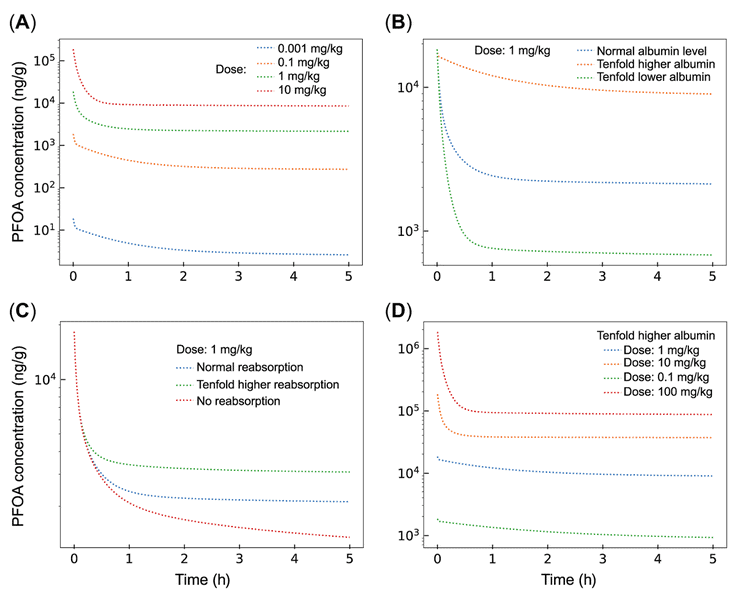
(A) Effect of dose on initial half‐life. (B) Effect of higher and lower levels of serum albumin, which binds to PFOA, on serum clearance dynamics. (C) Effect of extent of reabsorption in kidney on serum half‐life, based on organic anion transporting polypeptide 1a1 activity. (D) Effect of dose on elimination kinetics when half‐life is longer because of higher albumin binding.
Melanine
Melamine is commonly found in plastic food containers, particularly in items made from melamine-formaldehyde resins. While melamine provides heat resistance, it can migrate into food, especially when exposed to high temperatures.
Health risks include kidney toxicity, with the potential formation of kidney stones, and increases in urea levels. Its persistence in treatment systems further complicates its management.
A study in Taiwan aimed to establish a safety limit for melamine migration from food containers, particularly after the 2008 Chinese milk scandal, which affected over 290,000 individuals, primarily infants, leading to kidney abnormalities and, in some cases, death.
The study assessed risks for preschool children, individuals who dine out, and elderly residents. The recommended migration concentration limit (RMCL) for children aged 1-6 years was found to be 0.07 mg/dm², highlighting that children are at higher risk of melamine exposure than adults.
The safety limits used for comparison were 1.2 mg/L (0.2 mg/dm²) in China and 30 mg/L (5 mg/dm²) in the European Union.[13,14]
Heavy metals
Heavy metals are present in PVC packaging, plastic bags, and sometimes in recycled plastic products. These metals are used as stabilizers, colorants, or catalysts.
Despite regulations in many regions contamination with
- cadmium
- lead
- mercury
is still detected in some packaging, particularly in imported products or in countries with insufficient regulatory enforcement.
Exposure to these metals can result in
- carcinogenic effects
- kidney damage
- neurotoxicity
- bioaccumulation in ecosystems
Notably, cadmium and lead have been found in some high-density polyethylene (HDPE) packaging and PVC bags, with studies linking them to food contamination.
The study from China estimates the levels of 14 metals in leachates from disposable food containers exposed to hot water. Metals like Zink, Barium, Iron and Nickel were found in high concentrations.
The hazard quotient (HQ) for young adults was below 1, indicating no significant non-carcinogenic risk. However, the excess lifetime cancer risk (ELCR) for Nickel and Beryllium suggests a potential carcinogenic risk from chronic exposure.
The study highlights concerns about health risks associated with using disposable food containers in high-temperature environments.[15]
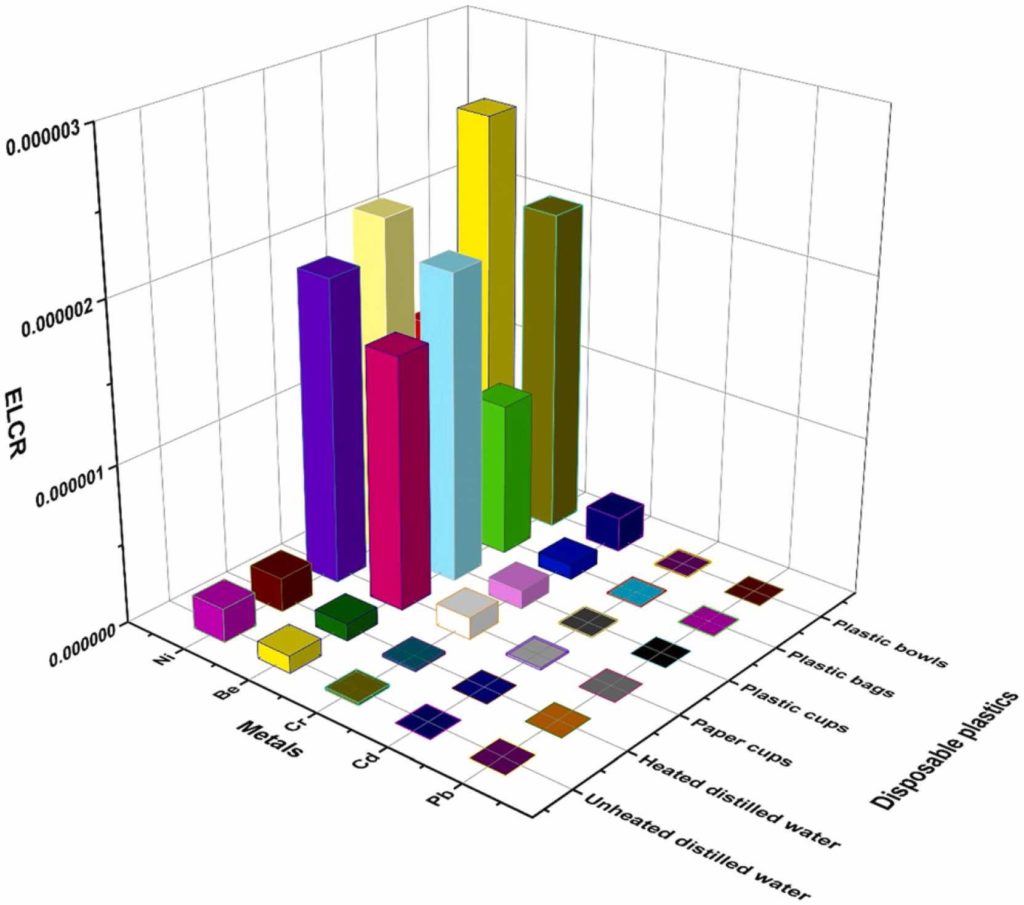
Non-Intentionally Added Substances (NIAS)
NIAS include impurities, degradation products, or residues from manufacturing. These are often found in recycled plastics and can include “legacy” chemicals such as polycyclic aromatic hydrocarbons (PAHs) and flame retardants.
For instance, recycled PS polymers have been shown to contain PAHs, which are carcinogenic. The variability and unpredictability of NIAS make their health effects harder to assess but equally concerning.
A study analyzing recycled polyethylene films identified over 300 chemical features, tentatively linking 83 compounds to NIAS. Additionally, research on recycled high-density polyethylene (HDPE) and low-density polyethylene (LDPE) packaging revealed the presence of contaminants, underscoring challenges in recycling practices.[16]
Irgafos 168
Irgafos 168, an antioxidant used in polyolefin plastics, generally does not have significant toxicological effects. However, concerns arise when it degrades into other compounds that may migrate into food, particularly during high-temperature processing.
Irgafos P-168 can degrade into potentially harmful compounds, such as di-tert-butyl-phenol and tris(2,4-di-tert-butylphenyl) phosphite, which are toxic.
Some regulations set their maximum concentrations between 5 and 40 mg/L, but studies have detected levels as high as 400 mg/L in polymer-based bottles containing this additive. In aquatic environments, Irgafos P-168 can hydrolyze over time, forming di-tert-butyl-phenol, a highly toxic substance.[17,18,19]
Environmental concerns
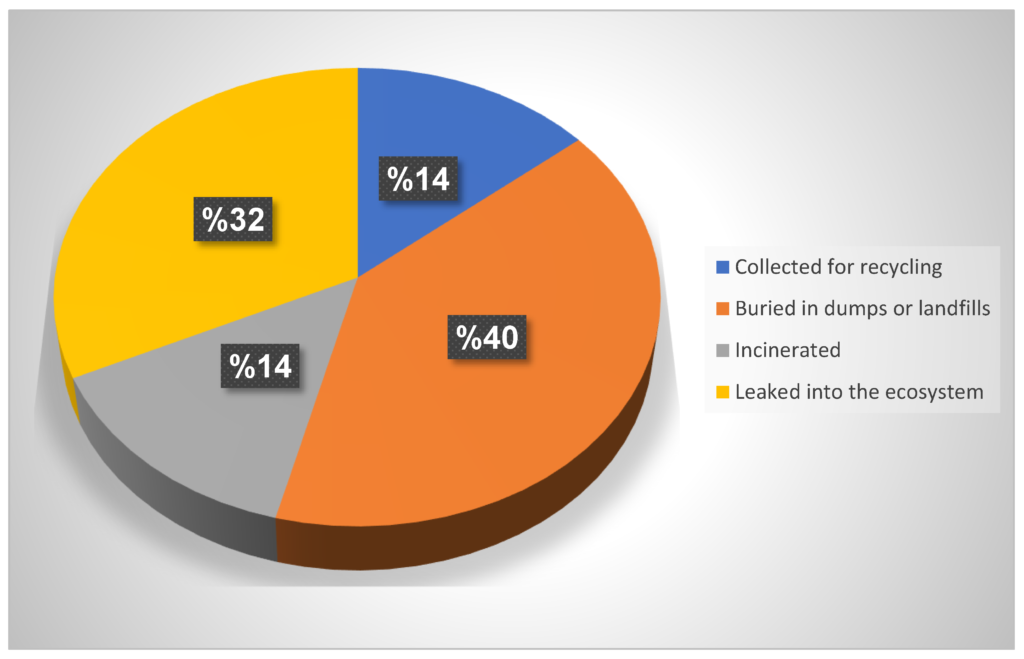
Plastic food packaging has become ubiquitous due to its convenience, low cost, and ability to preserve food. However, its environmental consequences are significant.
Key concerns
Pollution and slow rates of degradation
Plastics are non-biodegradable, persisting in the environment for centuries.
They accumulate in landfills, clog waterways, and infiltrate marine ecosystems, where they degrade into microplastics. These particles can harm marine life and enter the food chain, posing risks to human health.
Waste management challenges
The global recycling rate for plastic food packaging is remarkably low, with only about 14% being collected and even less successfully recycled.
Many countries, particularly in the developing world, lack adequate waste management infrastructure, leading to high rates of plastic pollution.
Greenhouse gas emissions
The production and disposal of plastics emit significant amounts of greenhouse gases, contributing to climate change. Incineration, a common disposal method, further releases harmful chemicals and carbon dioxide.
Health risks
Plastic packaging often contains additives like phthalates, which can leach into food and beverages, posing potential health risks. This contamination remains even when plastics are recycled.
Inefficient recycling systems
Contamination, mixed plastic types, and the high cost of sorting and cleaning materials hinder effective recycling. Moreover, repeated recycling degrades the quality of plastics, limiting their reusability.
Impact on wildlife
Plastic debris can entangle or be ingested by wildlife, causing injury or death. Littered packaging also serves as a breeding ground for disease-carrying pests.
Solutions and alternatives
To mitigate these issues, adopting a circular economy is critical. This involves reducing material use, increasing recycling rates, and innovating biodegradable and reusable packaging solutions.
Governments can enforce stricter regulations, implement bans or taxes on single-use plastics, and promote extended producer responsibility. Public awareness and shifts in consumer behavior are also essential to curb the reliance on disposable plastics.
The transition to sustainable packaging is not just an environmental imperative but also a socio-economic opportunity, fostering innovation and job creation while safeguarding natural ecosystems.
Related Questions
1. How long does BPA stay in the body?
BPA typically stays in the body for a few hours to a few days, as it is rapidly metabolized and excreted through urine.
However, continuous exposure may lead to accumulation over time.
2. Would microwave/oven safe plastic containers become unsafe to store food after continuous use?
Microwave/oven-safe plastic containers can degrade with continuous use, potentially releasing harmful chemicals.
Replacing them when scratched, warped, or discolored helps ensure food safety and prevents potential chemical leaching.
3. Is it safe to freeze food in plastic containers?
Freezing food in plastic containers is generally safe, but using BPA-free, freezer-safe plastics is recommended.
Brittle plastics may crack at low temperatures, potentially causing contamination or freezer burn over time.
If you are just joining us, we suggest reading Potential Health Risks of Food Packaging: Paper and Glass.
Michaela is a qualified food technologist, originally from the Czech Republic, where she successfully graduated and earned a Master’s degree from University of Chemistry and Technology. Michaela’s field of study was chemistry and analysis of food and natural products, and upon finishing her studies she became a part of an R&D team focusing on nutritional plant-based food…
If you would like to learn more about Mihaela, see Expert: Michaela Dvorakova.
References
(1) Jane Muncke, Food Packaging Materials. Retrieved from https://www.foodpackagingforum.org/resources/background-articles/food-packaging-materials
(2) S. Yenidoğan, C. Aydemir, and C. E. Doğan, Packaging-food interaction and chemical migration, Cellulose Chemistry and Technology, vol. 57, no. 9–10, 2023, doi: 10.35812/CelluloseChemTechnol.2023.57.91.
(3) Abdullahi, N. (2014). Hazard chemicals in some food packaging materials (a review). Annals. Food Science and Technology, 15(1).
(4) I. S. Arvanitoyannis and K. V. Kotsanopoulos, Migration Phenomenon in Food Packaging. Food-Package Interactions, Mechanisms, Types of Migrants, Testing and Relative Legislation-A Review’, 2014. doi: 10.1007/s11947-013-1106-8.
(5) Jadhav, E. B., Sankhla, M. S., Bhat, R. A., & Bhagat, D. S. (2021). Microplastics from food packaging: An overview of human consumption, health threats, and alternative solutions. In Environmental Nanotechnology, Monitoring and Management (Vol. 16).
(6) Kadac-Czapska, K., Knez, E., Gierszewska, M., Olewnik-Kruszkowska, E., & Grembecka, M. (2023). Microplastics Derived from Food Packaging Waste—Their Origin and Health Risks. In Materials (Vol. 16, Issue 2). https://doi.org/10.3390/ma16020674
(7) Claudio, L. (2012). Our food: Packaging & public health. In Environmental Health Perspectives (Vol. 120, Issue 6). https://doi.org/10.1289/ehp.120-a232
(8) Lisa Zimmermann. (2022, October 19). News Beyond BPA – Many bisphenols migrate from food packaging. Food Packaging Forum.
(9) Birgit Geueke. (2024, May 19). News Overview of use, migration, and hazards of PFAS in food contact materials. Food Packaging Forum.
(10) Trasande, L. (n.d.). ECHO Study Finds Link Between Phthalate Exposure and Preterm Birth, Estimates Potential Costs
(11) Zettergren, A., Andersson, N., Larsson, K., Kull, I., Melén, E., Georgelis, A., Berglund, M., Lindh, C., & Bergström, A. (2021). Exposure to environmental phthalates during preschool age and obesity from childhood to young adulthood. Environmental Research, 192. https://doi.org/10.1016/j.envres.2020.110249
(12) Fu, X., Xu, J., Zhang, R., & Yu, J. (2020). The association between environmental endocrine disruptors and cardiovascular diseases: A systematic review and meta-analysis. Environmental Research, 187, 109464. https://doi.org/10.1016/J.ENVRES.2020.109464
(13) Suzanne E. Fenton, Alan Ducatman, Alan Boobis, Jamie C. DeWitt, Christopher Lau, Carla Ng, James S. Smith, Stephen M. Roberts, Per‐ and Polyfluoroalkyl Substance Toxicity and Human Health Review: Current State of Knowledge and Strategies for Informing Future Research, Environmental Toxicology and Chemistry, Volume 40, Issue 3, 1 March 2021, Pages 606–630, https://doi.org/10.1002/etc.4890
(14) Ling, M. P., Lien, K. W., & Hsieh, D. P. H. (2016). Assessing Risk-Based Upper Limits of Melamine Migration from Food Containers. Risk Analysis, 36(12). https://doi.org/10.1111/risa.12585
(15) Zeng, X., Liu, D., Wu, Y., Zhang, L., Chen, R., Li, R., Gu, W., Zhang, L., Liu, C., & Sun, Q. (2023). Heavy metal risk of disposable food containers on human health. Ecotoxicology and Environmental Safety, 255. https://doi.org/10.1016/j.ecoenv.2023.114797
(16) Lisa Zimmermann. (2021, December 9). Study analyzes unknown chemicals in recycled plastic. Food Packaging Forum.
(17) Groh, K. J., Backhaus, T., Carney-Almroth, B., Geueke, B., Inostroza, P. A., Lennquist, A., Leslie, H. A., Maffini, M., Slunge, D., Trasande, L., Warhurst, A. M., & Muncke, J. (2019). Overview of known plastic packaging-associated chemicals and their hazards. In Science of the Total Environment (Vol. 651). https://doi.org/10.1016/j.scitotenv.2018.10.015
(18) Taylor, R. B., & Sapozhnikova, Y. (2022). Assessing Chemical Migration from Plastic Food Packaging into Food Simulant by Gas and Liquid Chromatography with High-Resolution Mass Spectrometry. Journal of Agricultural and Food Chemistry, 70(16).
(19) Hernández-Fernández, J., Cano, H., & Reyes, A. F. (2023). Valoration of the Synthetic Antioxidant Tris-(Diterbutyl-Phenol)-Phosphite (Irgafos P-168) from Industrial Wastewater and Application in Polypropylene Matrices to Minimize Its Thermal Degradation. Molecules, 28(7). https://doi.org/10.3390/molecules28073163

